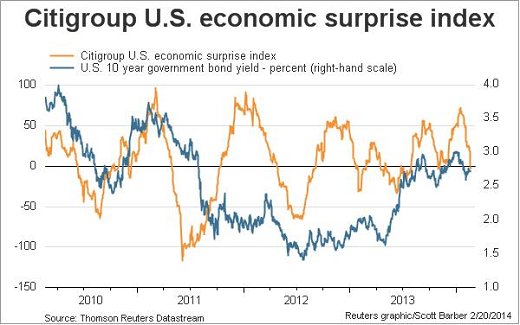What's troubling the economy?
The U.S. economy has been a bit of a head-scratcher lately.
After finishing 2013 strongly, both GDP growth and job creation have stalled. Monthly payroll gains averaged 225,000 in the three months through December but have averaged just 94,000 so far this year. And GDP, which averaged a 3.7 percent annualized growth rate in third- and fourth-quarter 2013, is on track to post a meager 1.5 percent result in this year's first quarter, according to the tracking estimate from Macroeconomic Advisors.
Many are pointing to the severe winter weather we've seen this season as the primary cause -- providing justification to dismiss this slowing as a temporary hiccup. And surely, Mother Nature is landing some blows.
But let's not discount the impact that the mid-2013 surge in long-term interest rates -- as the Fed started hinting the taper cometh -- that pushed 10-year Treasury yields from 1.7 percent in May to a high of 3.04 percent at year-end. Monetary policy operates with a nine-month lag. So, we're just now starting to feel the impact of the rate increase from the May low.
It'll only get worse from here.
For one, consumers have been under pressure for a few months as real disposable personal income collapses on a scale not seen since the mid-1970s recession, down 2.7 percent in December from the year prior and well off of the 2.2 percent year-over-year growth posted back in October.
So, it's no surprise that retail sales are wilting, growing in January at the slowest rate during the recovery thus far.
Higher rates (and yes, bad weather) are also sucking the wind out of the housing market. Homebuilder confidence, housing starts and home sales have all disappointed lately. Mortgage demand is down, according to the Fed's loan officer survey. A combination of pinched incomes and interest rates that remain high after last year's "taper tantrum" is a toxic one -- even before considering the impact of snow and ice on open-house visits and buyer traffic.
Manufacturers also look to be in trouble as inventories build, new orders dry up and production slows.
Overall, you can see the rollover in the data in the chart of the Citigroup Economic Surprise Index. When the data disappointed analyst estimates, as it is now, the yellow line drops.
Stocks have been taking this all in stride, secure in the belief that should the weakness continue into the spring, Federal Reserve policymakers will respond. They could halt the ongoing tapering of the "QE3" bond purchase program. Or they could continue to extend out their estimate of the timing of their first short-term interest rate hike.
As long as inflation remains contained, the thinking goes, the Fed will take action. Its preferred inflation measure averaged a 0.9 percent annual rate in the final three months of 2013, well below the Fed's 2 percent target and the 2.5 percent threshold it has highlighted as the point at which rates would start rising.
For investors, all of this translates into a situation where inflation is all but assured to increase in 2014 -- which explains the intense buying seen over the last couple of weeks in areas like gold, silver and the related mining stocks, as well as crude oil and agricultural commodities. All act as hedges against rising prices.
Examples include Great Panther Silver (GPL), up more than 30 percent since I added it to my Edge Letter Sample Portfolio, or Silver Wheaton (SLW), up 9.1%. For broader exposure, the Global X Silver Miners (SIL) is up 11.2% since I added it on Feb. 11.
Disclosure: Anthony
has recommended GPL, SLW, and SIL to his clients.
Anthony Mirhaydari is founder of the Edge and Edge Pro investment advisory
newsletters, as well as Mirhaydari
Capital Management, a registered investment advisory firm.

